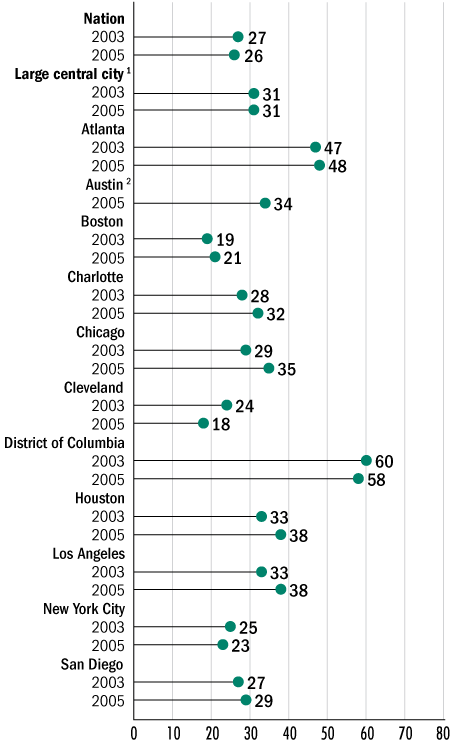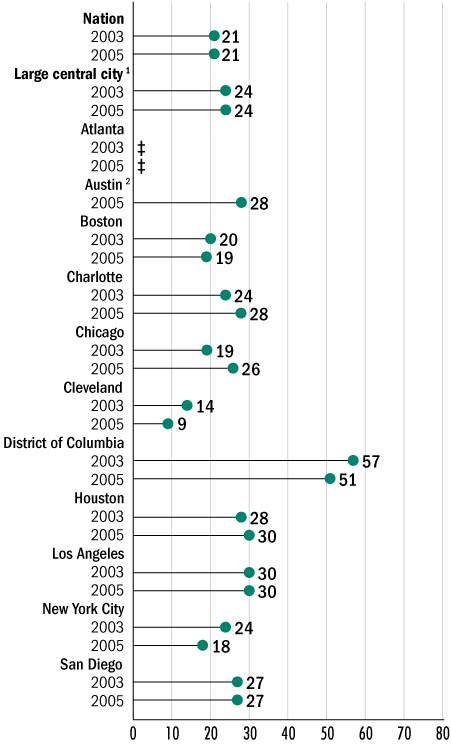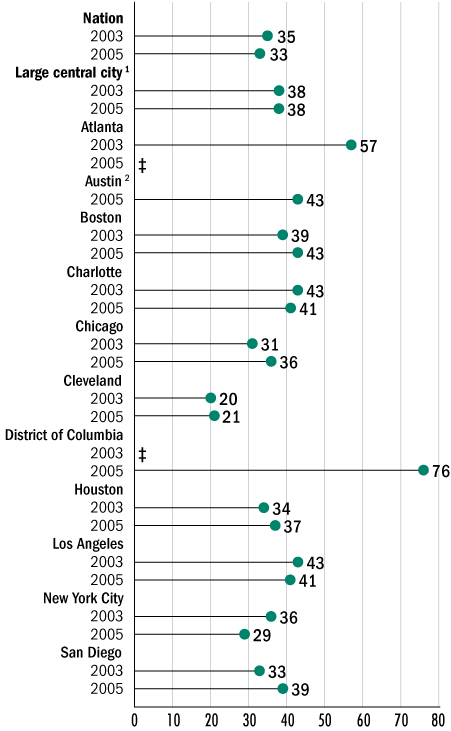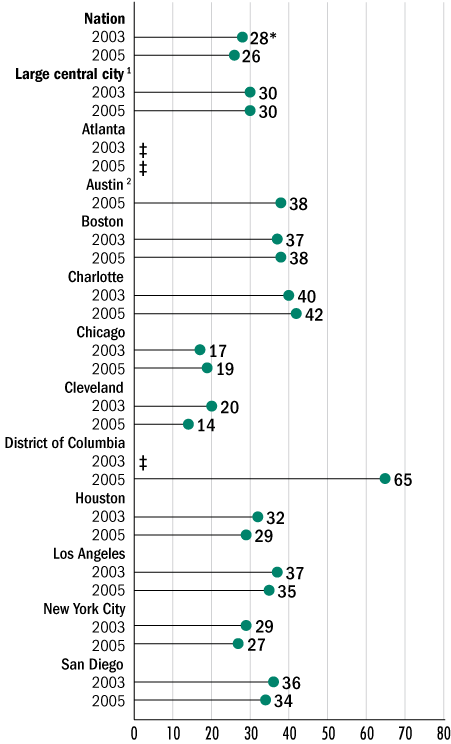|
|
 5 of 12 5 of 12 
|
|
District Mathematics Results by Race/Ethnicity
At grade 4, compared to students with the same race/ethnicity in large central city schools...
- White students in Atlanta, Austin, Charlotte, the District of Columbia, and Houston had higher average scores. White students in Atlanta, Austin, Charlotte, Houston, and San Diego had higher percentages performing at or above Basic. White students in Cleveland had lower average scores.
- Black students in Austin, Boston, Charlotte, Houston, and New York City had higher average scores. Black students in Chicago, the District of Columbia, and Los Angeles had lower average scores.
- Hispanic students in Austin, Charlotte, Houston, and New York City had higher average scores. Hispanic students in Chicago, the District of Columbia, and Los Angeles had lower average scores.
- Asian/Pacific Islander students in Boston, Charlotte, and New York City had higher average scores. Asian/Pacific Islander students in Boston and New York City had higher percentages performing at or above Basic.
At grade 8, compared to students with the same race/ethnicity in large central city schools...
- White students in Austin, Boston, Charlotte, and the District of Columbia had higher average scores. White students in Cleveland and Los Angeles had lower average scores.White students in Austin, Charlotte, and the District of Columbia had higher percentages performing at or above Basic. White students in Cleveland had lower percentages performing at or above Basic.
- Black students in Austin, Boston, Charlotte, Houston, and New York City had higher average scores. Black students in Atlanta, Chicago, Cleveland, the District of Columbia, and Los Angeles had lower average scores.
- Hispanic students in Austin, Chicago, and Houston had higher average scores. Hispanic students in Los Angeles had a lower average score.
- Asian/Pacific Islander students in Boston had higher average scores and higher percentages performing at or above Basic.
|
Grade 4
- White Students
- Black Students
- Hispanic Students
- Asian/Pacific Islander Students
- White-Black Gap
- White-Hispanic Gap
- Distribution of Student Groups
Average scale scores and percentage of White students within each achievement level in mathematics, grade 4 public schools: By urban district, 2005
Average scale scores and percentage of Black students within each achievement level in mathematics, grade 4 public schools: By urban district, 2005
Average scale scores and percentage of Hispanic students within each achievement level in mathematics, grade 4 public schools: By urban district, 2005
Average scale scores and percentage of Asian/Pacific Islander students within each achievement level in mathematics, grade 4 public schools: By urban district, 2005
White-Black gap in average mathematics scores, grade 4 public schools: By urban district, various years, 2002–2005
White average score minus Black average score

Score gaps
White-Hispanic gap in average mathematics scores, grade 4 public schools: By urban district, various years, 2002–2005
White average score minus Hispanic average score

Score gaps
Percentage of students by race/ethnicity, mathematics assessment, grade 4 public schools: By urban district, 2005
|
District
|
White |
Black |
Hispanic |
Asian/Pacific
Islander |
American Indian/
Alaska Native |
Unclassified1 |
| 57 |
17 |
20 |
4 |
1 |
1 |
| 21 |
32 |
39 |
6 |
1 |
1 |
| 11 |
84 |
3 |
1 |
# |
1 |
| 28 |
14 |
55 |
3 |
# |
# |
| 13 |
45 |
32 |
9 |
# |
# |
| 41 |
40 |
11 |
5 |
# |
3 |
| 8 |
47 |
42 |
3 |
# |
# |
| 20 |
70 |
7 |
1 |
# |
3 |
| 4 |
86 |
8 |
1 |
# |
# |
| 10 |
28 |
59 |
3 |
# |
# |
| 10 |
10 |
74 |
6 |
# |
# |
| 14 |
35 |
39 |
12 |
# |
# |
| 23 |
14 |
44 |
17 |
1 |
# |
Grade 8
- White Students
- Black Students
- Hispanic Students
- Asian/Pacific Islander Students
- White-Black Gap
- White-Hispanic Gap
- Distribution of Student Groups
Average scale scores and percentage of White students within each achievement level in mathematics, grade 8 public schools: By urban district, 2005
Average scale scores and percentage of Black students within each achievement level in mathematics, grade 8 public schools: By urban district, 2005
Average scale scores and percentage of Hispanic students within each achievement level in mathematics, grade 8 public schools: By urban district, 2005
Average scale scores and percentage of Asian/Pacific Islander students within each achievement level in mathematics, grade 8 public schools: By urban district, 2005
White-Black gap in average mathematics scores, grade 8 public schools: By urban district, various years, 2002–2005
White average score minus Black average score

Score gaps
White-Hispanic gap in average mathematics scores, grade 8 public schools: By urban district, various years, 2002–2005
White average score minus Hispanic average score

Score gaps
Percentage of students by race/ethnicity, mathematics assessment, grade 8 public schools: By urban district, 2005
|
District
|
White |
Black |
Hispanic |
Asian/Pacific
Islander |
American Indian/
Alaska Native |
Unclassified1 |
| 60 |
17 |
17 |
5 |
1 |
1 |
| 24 |
32 |
36 |
8 |
1 |
1 |
| 5 |
93 |
2 |
# |
# |
# |
| 33 |
13 |
51 |
3 |
# |
# |
| 16 |
45 |
28 |
11 |
# |
1 |
| 38 |
48 |
9 |
4 |
1 |
1 |
| 12 |
45 |
38 |
4 |
# |
# |
| 18 |
70 |
10 |
1 |
# |
1 |
| 4 |
88 |
7 |
1 |
# |
# |
| 10 |
28 |
58 |
4 |
# |
# |
| 9 |
13 |
72 |
6 |
# |
# |
| 15 |
35 |
38 |
13 |
# |
# |
| 26 |
15 |
41 |
17 |
1 |
# |
|
Learn more about the NAEP reporting groups on the NAEP website.
|
|
|